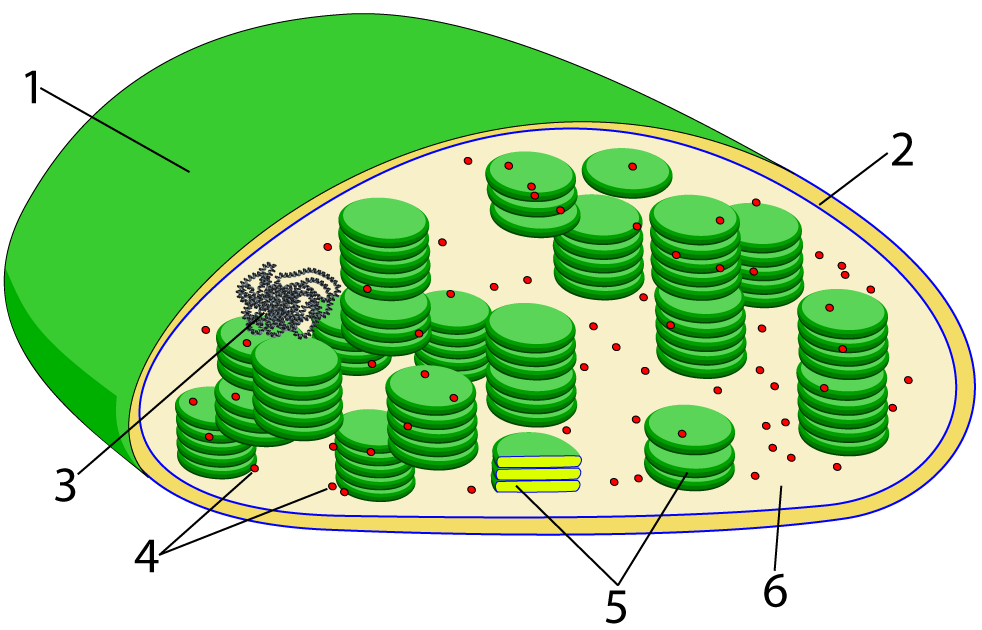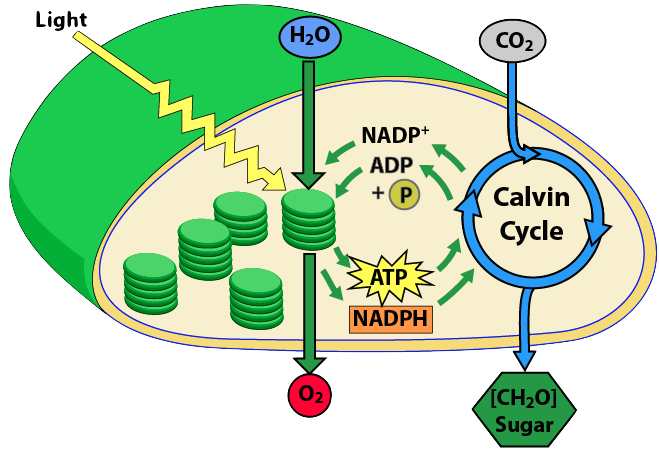Status: READY FOR REVIEW
1. Introduction
In the last tutorial, we looked at photosynthesis on a big-picture level. In this tutorial and the next two, we’re going to go inside the chloroplast to see how this organelle carries out the complex chemical reactions of photosynthesis.
The key question to hold in mind is this: how does a chloroplast convert light energy into the chemical energy in glucose?
To review the big picture, answer the questions below.
[qwiz style=” width: 600px !important; min-height: 400px !important;” qrecord_id=”sciencemusicvideosMeister1961-PSN, Big Picture Review (HS)”]
[h] Photosynthesis: Big Picture Review
[q]
[c]IGxpZ2h0[Qq]
[f]IENvcnJlY3Qh[Qq]
[c]IGNhcmJvbiBkaW94aWRl[Qq]
[f]IEdyZWF0IQ==[Qq]
[c]IHdhdGVy[Qq]
[f]IEV4Y2VsbGVudCE=[Qq]
[c]IGNhcmJvaHlkcmF0ZQ==[Qq]
[f]IEdvb2Qh[Qq]
[c]IG94eWdlbg==[Qq]
[f]IENvcnJlY3Qh[Qq]
[q]
[c]IGxpZ2h0[Qq]
[f]IEdyZWF0IQ==[Qq]
[c]IGNhcmJvbiBkaW94aWRl[Qq]
[f]IEdvb2Qh[Qq]
[c]IHdhdGVy[Qq]
[f]IEV4Y2VsbGVudCE=[Qq]
[c]IGdsdWNvc2U=[Qq]
[f]IEdvb2Qh[Qq]
[c]IG94eWdlbg==[Qq]
[f]IEdvb2Qh[Qq]
[/qwiz]
2. Chloroplast structure
 As we discussed in the last tutorial, the chloroplasts found in plants and algae are the descendants of photosynthetic bacteria called cyanobacteria. Between between one and two billion years ago, one or more cyanobacteria took up residence inside a larger, eukaryotic cell. Over time, these cyanobacteria evolved into chloroplasts. To learn more about chloroplast evolution, read this article on Wikipedia.
As we discussed in the last tutorial, the chloroplasts found in plants and algae are the descendants of photosynthetic bacteria called cyanobacteria. Between between one and two billion years ago, one or more cyanobacteria took up residence inside a larger, eukaryotic cell. Over time, these cyanobacteria evolved into chloroplasts. To learn more about chloroplast evolution, read this article on Wikipedia.
The structure of a chloroplast shows evidence of the chloroplast’s bacterial origins. Like the cyanobacteria they evolved from, chloroplasts have a double membrane. The outer membrane is shown at “1” and the inner membrane is shown at “2.”
Chloroplasts, like mitochondria (which also evolved from free-living bacterial ancestors), have their own DNA (at “3”). This DNA is organized like the DNA of bacteria: it’s a single, looped chromosome. Number 4 shows another structure that only makes sense in light of the chloroplast’s bacterial origins. These are ribosomes. These ribosomes are similar in structure to bacterial ribosomes. Chloroplasts use them to synthesize some of their own proteins.
Chloroplasts are filled with tiny, membrane-bound sacs called thylakoids (“5”), which are organized into stacks (like a stack of pancakes). The thylakoids capture light energy, and this arrangement maximizes the surface area for capturing light. Outside of the thylakoid is a fluid called the stroma (“6”), which is like the the cytoplasm of a bacterial cell.
3. Photosynthesis involves three energy transformations
During photosynthesis, chloroplasts carry out three energy transformations.
-

The first energy transformation in photosynthesis converts light energy into electricity. LIGHT TO ELECTRICITY: The first transformation takes light energy and converts it into an electrical current. If you need an analogy, this is what a solar panel does (though the mechanism is different).
- ELECTRICITY TO SHORT-TERM-CHEMICAL ENERGY: The second transformation takes this electrical current and converts it into short-term chemical energy. This chemical energy is stored in two short-lived compounds: ATP and NADPH.
- ATP (which you learned about in our tutorial about cellular respiration) is an energy transfer molecule that’s used in all living things to power cellular work: growing, transporting, moving, repairing, reproducing, etc.
- NADPH belongs to a class of molecules that are called electron carriers. (Note: if NADPH is reminding you of NADH from cellular respiration, that’s good. The two molecules are similar and play similar roles).
- SHORT TERM CHEMICAL ENERGY TO LONG TERM CHEMICAL ENERGY: The third transformation uses the energy in ATP and NADPH to convert carbon dioxide gas into glucose (a simple sugar). Glucose can be used for energy (to power cellular respiration), and for supplying the atoms the cell needs in order to grow, repair, and reproduce. This third reaction is the basis for almost all of the food eaten by all the organisms on planet Earth.
ATP and NADPH are molecules that switch back and forth between high energy and low energy forms.
![]() When cells have work to do, they’ll convert ATP (the high energy form), to ADP and phosphate (the low energy form). This transformation makes energy available that the cell can use to repair itself, to move, to reproduce, etc.
When cells have work to do, they’ll convert ATP (the high energy form), to ADP and phosphate (the low energy form). This transformation makes energy available that the cell can use to repair itself, to move, to reproduce, etc.
Conversely, cells can take available energy and use it to combine ADP and a phosphate group into ATP. Where does that energy come from? In photosynthesis, that energy comes from light. In cellular respiration, it comes from food.
NADPH, along with its low energy counterpart NADP+, functions like a rechargeable molecular battery.

NADP+ is like a dead battery. Charging it up with electrons converts NADP+ into NADPH, which is like a charged up battery. As we’ll see in the next tutorial, the electrons that are used to charge up NADP+ come from water, and they’re charged up by light energy that’s captured by a chloroplast.
In the last phase of photosynthesis, NADPH will provide the high energy electrons that are used to convert carbon dioxide, CO2, into glucose, C6H12O6.
4. The Two Phases of Photosynthesis
The first two energy transformations — converting light into electricity and then using this electricity to make ATP and NADPH — make up what are known as the light-dependent reactions of photosynthesis (or sometimes just the light reactions). As you might guess, these reactions only occur when light is present. They stop completely at night, and they slow down when light becomes less intense (on a cloudy day, or during winter).
The last transformation — using the energy in ATP and NADPH to convert carbon dioxide into glucose — is called the Calvin Cycle. This cycle is named for UC Berkeley biochemist Melvin Calvin, who won the 1961 Nobel Prize for his work figuring out how the cycle works.
The diagram below shows the light dependent reactions and the Calvin cycle. Because of the complexity of the diagram, I’m providing you with both a labeled and an unlabeled version of the diagram.
The light reactions make up Phase I (represented by Roman numeral “I” in the diagram below). In a reaction powered by light energy (“1”), water (at “2”) gets split apart into high energy electrons and protons (neither of which are shown below). These electrons and protons are used to charge up the electron carrier NADP+ (shown at “8”) into its high energy form, NADPH (shown at “5”). Energy harvested during the light reactions is also used to convert low energy ADP and phosphate (“9” and “10,” respectively) into high energy ATP (“4”). The waste product is oxygen, shown at “3”.
All of this occurs in the thylakoid sacs, with the outputs of the light reactions (NADPH and ATP) moving into the stroma to support photosynthesis’ second phase.
 |
 |
Phase II of photosynthesis is the Calvin Cycle, and it occurs in the stroma (shown at “b” in the diagram on the left side). The Calvin Cycle uses the NADPH and ATP made during Phase 1 as inputs. Note that oxygen is not used, which is why oxygen is a waste product.
Because the Calvin cycle doesn’t depend directly on light, you’ll also see it referred to as the light independent reactions, or even the dark reactions.
During the Calvin Cycle, the key external input is carbon dioxide (“6”). Using energy from ATP (“4”), and electrons (and hydrogen) from the electron carrier NADPH (“5”), carbon dioxide is converted into sugars such as glucose (“7”), which can then be converted into other carbohydrates (like starch and cellulose), and other molecules like proteins, lipids, and nucleic acids.
5. Checking Understanding: The Two Phases of Photosynthesis
In the next tutorials, we’ll dive into the details of the light reactions and the Calvin cycle. But let’s consolidate what we’ve learned above through the following quiz. Just to keep the memories intact, I’ll throw in a few questions from the last tutorial.
[qwiz random = “false” qrecord_id=”sciencemusicvideosMeister1961-Two Phases of Photoynthesis (HS)”]
[h]The Two Phases of Photosynthesis
[i]
[q]The correct chemical equation for photosynthesis is
[c]IEM=Ng==SA==MTI=Tw==[Qq]6 + 6CO2 + energy(ATP) → 6CO2 + 6O2
[c]IEM=Ng==SA==MTI=Tw==[Qq]6 + 6O2 → energy(ATP) + 6CO2 + 6H2O
[c]IDZD Tw==Mg==ICsgNkg=Mg==TyArIEVuZXJneShsaWdodCkg[Qq]→ C6H12O6 + 6O2
[c]IDZIMg==TyArIDZPMsKg[Qq]→ 6CO2 + 6H2O
[f]IE5vLiBUaGUgcmVhY3Rpb24gYWJvdmUgc2hvd3MgZ2x1Y29zZSBiZWluZyBjb21iaW5lZCB3aXRoIGNhcmJvbiBkaW94aWRlLiBJbiBwaG90b3N5bnRoZXNpcywgY2FyYm9uIGRpb3hpZGUgaXMgY29tYmluZWQgd2l0aCB3YXRlciB0byBjcmVhdGUgZ2x1Y29zZSwgd2l0aCBveHlnZW4gcmVsZWFzZWQgYXMgYSBieXByb2R1Y3Qu[Qq]
[f]IE5vLiBJbiBwaG90b3N5bnRoZXNpcywgY2FyYm9uIGRpb3hpZGUgaXMgY29tYmluZWQgd2l0aCB3YXRlciB0byBjcmVhdGUgZ2x1Y29zZSwgd2l0aCBveHlnZW4gcmVsZWFzZWQgYXMgYSBieXByb2R1Y3Qu[Qq]
[f]IEZhYnVsb3VzLiBJbiBwaG90b3N5bnRoZXNpcywgY2FyYm9uIGRpb3hpZGUgaXMgY29tYmluZWQgd2l0aCB3YXRlciB0byBjcmVhdGUgZ2x1Y29zZSwgd2l0aCBveHlnZW4gcmVsZWFzZWQgYXMgYSBieXByb2R1Y3Qu[Qq]
[f]IE5vLiBGaW5kIGEgcmVhY3Rpb24gdGhhdCBiZWdpbnMgd2l0aCBjYXJib24gZGlveGlkZSBhbmQgd2F0ZXIsIGFuZCBjb21iaW5lcyB0aG9zZSBpbnB1dHMgdG8gY3JlYXRlIGdsdWNvc2UsIHdpdGggb3h5Z2VuIHJlbGVhc2VkIGFzIGEgYnlwcm9kdWN0Lg==[Qq]
[q]Hint: in number 3, name the specific substance.
[c]IGxpZ2h0[Qq]
[c]IGNhcmJvbiBkaW94aWRl[Qq]
[c]IHdhdGVy[Qq]
[c]IGdsdWNvc2U=[Qq]
[c]IG94eWdlbg==[Qq]
[c]IGNobG9yb3BsYXN0[Qq]
[c]IG1pdG9jaG9uZHJpb24=[Qq]
[c]IEFUUA==[Qq]
[q] The first organisms to perform photosynthesis were
[c]IGFsZ2FlLCBsaWtlIG1vZGVybiBzZWF3ZWVkcy4=[Qq]
[f]IE5vLiBBbGdhZSBhcmUgZXVrYXJ5b3Rlcy4gUHJva2FyeW90aWMgcGhvdG9zeW50aGVzaXplcnMgcHJlY2VkZWQgdGhlbSBieSB0d28gYmlsbGlvbiB5ZWFycy4gSW4gdGhlIGxpc3QgYWJvdmUsIHdoaWNoIG9yZ2FuaXNtcyB3ZXJlIHByb2thcnlvdGljPw==[Qq]
[c]IGN5YW5vYm FjdGVyaWEu[Qq]
[f]IEV4Y2VsbGVudC4gQ3lhbm9iYWN0ZXJpYSBhcmUgcGhvdG9zeW50aGVzaXppbmcgYmFjdGVyaWEsIGFuZCBhcmUgdGhvdWdodCB0byBiZSB0aGUgZmlyc3QgcGhvdG9zeW50aGVzaXppbmcgb3JnYW5pc21zLg==[Qq]
[c]IHNpbXBsZSBwbGFudHMsIGxpa2UgbW9zc2VzIGFuZCBmZXJucy4=[Qq]
[f]IE5vLiBMYW5kIHBsYW50cywgZXZlbiBtb3NzZXMgYW5kIGZlcm5zLCBoYXZlIG9ubHkgYmVlbiBhcm91bmQgZm9yIGFib3V0IDQwMCBtaWxsaW9uIHllYXJzLiBUaGV5IHdlcmUgcHJlY2VkZWQgYnkgcGhvdG9zeW50aGV0aWMgcHJva2FyeW90ZXMgYnkgdGhyZWUgYmlsbGlvbiB5ZWFycy4gSW4gdGhlIGxpc3QgYWJvdmUsIHdoaWNoIG9yZ2FuaXNtcyB3ZXJlIHByb2thcnlvdGljPw==
Cg==[Qq]
[q dataset_id=”SMV_PSN_Two_Phases_of_PSN|716da41c2b1e4″ question_number=”2″] In the diagram below, which number shows the cells that secrete the upper waxy layer that helps prevent water loss?
[textentry single_char=”true”]
[c]ID I=[Qq]
[f]IEV4Y2VsbGVudC4gVGhlIHVwcGVyIGVwaWRlcm1pcyBzZWNyZXRlcyB0aGUgd2F4eSBsYXllciB0aGUgaGVscHMgbWluaW1pemUgd2F0ZXIgbG9zcy4=[Qq]
[c]IEVudGVyIHdvcmQ=[Qq]
[f]IE5vLCB0aGF0JiM4MjE3O3Mgbm90IGNvcnJlY3Qu[Qq]
[c]ICo=[Qq]
[f]IE5vLiBIZXJlJiM4MjE3O3MgYSBoaW50LiBUaGUgdXBwZXIgd2F4eSBsYXllciBpcyByaWdodCBuZXh0IHRvIHRoZSBjZWxscyB0aGF0IHNlY3JldGUgdGhhdCBsYXllci4gV2hpY2ggY2VsbHMgYXJlIHJpZ2h0IG5leHQgdG8gdGhlIHVwcGVyIHdheHkgbGF5ZXI/
Cg==[Qq]
[q dataset_id=”SMV_PSN_Two_Phases_of_PSN|71692145215e4″ question_number=”3″] In the diagram below, which number shows the organelle that’s performing photosynthesis?
[textentry single_char=”true”]
[c]ID M=[Qq]
[f]IFRlcnJpZmljLiAmIzgyMjA7MyYjODIyMTsgaW5kaWNhdGVzIHRoZSBjaGxvcm9wbGFzdHMsIHRoZSBvcmdhbmVsbGVzIHRoYXQgYXJlIHBlcmZvcm1pbmcgcGhvdG9zeW50aGVzaXMu[Qq]
[c]ICo=[Qq]
[f]IE5vLiBIZXJlJiM4MjE3O3MgYSBoaW50LiBZb3UmIzgyMTc7cmUgbG9va2luZyBmb3IgYW4gb3JnYW5lbGxlOiBzb21ldGhpbmcgaW5zaWRlIGEgY2VsbC4=
Cg==[Qq]
[q dataset_id=”SMV_PSN_Two_Phases_of_PSN|7164792d595e4″ question_number=”4″] Photosynthesis requires carbon dioxide as an input. Which part shows where carbon dioxide would enter the leaf?
[textentry single_char=”true”]
[c]ID c=[Qq]
[f]IE5pY2UgSm9iISAmIzgyMjA7NyYjODIyMTsgaW5kaWNhdGVzIHRoZSBzdG9tYXRhLCBhbiBvcGVuaW5nIGZvcm1lZCBieSBndWFyZCBjZWxscyB0aHJvdWdoIHdoaWNoIGNhcmJvbiBkaW94aWRlIGNhbiBkaWZmdXNlIGludG8gdGhlIGxlYWYu[Qq]
[c]ICo=[Qq]
[f]IE5vLiBIZXJlJiM4MjE3O3MgYSBoaW50LiBXaGVyZSBpcyB0aGVyZSBhIGdhcCBpbiB0aGUgc3VyZmFjZSBvZiB0aGUgbGVhZiB0aHJvdWdoIHdoaWNoIGNhcmJvbiBkaW94aWRlIChhIGdhcykgY291bGQgZGlmZnVzZSBpbnRvIHRoZSBsZWFmPw==[Qq]
[q]The cyanobacteria shown below are the ancestors of the [hangman] found in the cells of plants and algae.
[c]Y2hsb3JvcGxhc3Rz
Cg==[Qq]
[q dataset_id=”SMV_PSN_Two_Phases_of_PSN|7156cb677dde4″ question_number=”7″] The light reactions occur in which part?
[textentry single_char=”true”]
[c]NQ ==[Qq]
[f]QXdlc29tZSEgJiM4MjIwOzUmIzgyMjE7IHNob3dzIHRoZSB0aHlsYWtvaWQgc2Fjcywgd2hpY2ggaXMgd2hlcmUgdGhlIGxpZ2h0IHJlYWN0aW9ucyBvY2N1ci4=[Qq]
[c]ICo=[Qq]
[f]IE5vLiBIZXJlJiM4MjE3O3MgYSBoaW50LiBZb3UmIzgyMTc7cmUgbG9va2luZyBmb3IgdGhlIHRoeWxha29pZCBzYWNzLg==
Cg==[Qq]
[q dataset_id=”SMV_PSN_Two_Phases_of_PSN|7152234fb5de4″ question_number=”8″] The Calvin Cycle occurs in which part of the chloroplast?
[textentry single_char=”true”]
[c]Ng ==[Qq]
[f]QXdlc29tZSEgJiM4MjIwOzYmIzgyMjE7IHNob3dzIHRoZSBzdHJvbWEsIHdoaWNoIGlzIHdoZXJlIHRoZSBDYWx2aW4gQ3ljbGUgb2NjdXJzLg==[Qq]
[c]ICo=[Qq]
[f]IE5vLiBIZXJlJiM4MjE3O3MgYSBoaW50LiBUaGUgQ2FsdmluIEN5Y2xlIG9jY3VycyBpbiB3aGF0JiM4MjE3O3MgZXNzZW50aWFsbHkgdGhlIGN5dG9wbGFzbSBvZiB0aGUgY2hsb3JvcGxhc3Qu
Cg==[Qq]
[q dataset_id=”SMV_PSN_Two_Phases_of_PSN|714d7b37edde4″ question_number=”9″]One of the strongest pieces of evidence for the cyanobacterial origins of chloroplasts is the fact that they have their own DNA. Which number indicates DNA?
[textentry single_char=”true”]
[c]Mw ==[Qq]
[f]QXdlc29tZSEgJiM4MjIwOzMmIzgyMjE7IHNob3dzIHRoZSBjaGxvcm9wbGFzdCYjODIxNztzIGNpcmN1bGFyLCBiYWN0ZXJpYS1saWtlIGNocm9tb3NvbWUuIFRoZSBleGlzdGVuY2Ugb2YgdGhpcyBjaHJvbW9zb21lIGlzIG9uZSBwaWVjZSBvZiBldmlkZW5jZSBmb3IgdGhlIGlkZWEgdGhhdCBjaGxvcm9wbGFzdHMgd2VyZSBvbmNlIGZyZWUgbGl2aW5nLCBpbmRlcGVuZGVudCBiYWN0ZXJpYSB0aGF0IGF0IG9uZSBwb2ludCwgdG9vayB1cCByZXNpZGVuY2Ugd2l0aGluIGFub3RoZXIgY2VsbC4=[Qq]
[c]ICo=[Qq]
[f]IE5vLiBIZXJlJiM4MjE3O3MgYSBoaW50LiBETkEgaXMgYSBsb25nIHNraW5ueSBtb2xlY3VsZS4gSW4gYmFjdGVyaWEsIHRoZSBETkHCoCBpcyBvcmdhbml6ZWQgaW50byBhIGJpZyBsb29wZWQgY2hyb21vc29tZS4gV2hpY2ggcGFydCBvZiB0aGUgZGlhZ3JhbSBpcyB0aGUgb25seSB0aGluZyB0aGF0IGNvdWxkIGZpdCB0aGF0IGRlc2NyaXB0aW9uPw==
Cg==[Qq]
[q dataset_id=”SMV_PSN_Two_Phases_of_PSN|7148f860e41e4″ question_number=”10″]If number 4 represents ATP, then which number would represent NADP+?
[textentry single_char=”true”]
[c]OA ==[Qq]
[f]QXdlc29tZSEgJiM4MjIwOzgmIzgyMjE7IGlzIE5BRFA=Kw==LCB3aGljaCBnZXRzIGNoYXJnZWQgdXAgYnkgdGhlIGxpZ2h0IHJlYWN0aW9ucyB0byBmb3JtIE5BRFBI[Qq]
[c]ICo=[Qq]
[f]IE5vLiBIZXJlJiM4MjE3O3MgYSBoaW50LiBJZiAmIzgyMjA7NCYjODIyMTsgaXMgQVRQLCB0aGVuIDkgYW5kIDEwIHdvdWxkIGJlIEFEUCBhbmQgUC4gQmVzaWRlcyB3YXRlciwgd2hhdCYjODIxNztzIHRoZSBvdGhlciBpbnB1dCBmb3IgdGhlIGxpZ2h0IHJlYWN0aW9ucz8=
Cg==[Qq]
[q dataset_id=”SMV_PSN_Two_Phases_of_PSN|71447589da5e4″ question_number=”11″]What letter or number represents the stroma?
[textentry single_char=”true”]
[c]Yg ==[Qq]
[f]QXdlc29tZSEgTGV0dGVyICYjODIyMDtiJiM4MjIxOyByZXByZXNlbnRzIHRoZSBzdHJvbWEu[Qq]
[c]ICo=[Qq]
[f]IE5vLiBIZXJlJiM4MjE3O3MgYSBoaW50LiBJZiBhIGNobG9yb3BsYXN0IGhhZCBjeXRvcGxhc20sIHRoaXMgd291bGQgYmUgaXQu
Cg==[Qq]
[q dataset_id=”SMV_PSN_Two_Phases_of_PSN|713fcd72125e4″ question_number=”12″]If 9 is ADP, then what letter or number represents the electron carrier molecule that’s an output of the light reactions and an input for the Calvin cycle?
[textentry single_char=”true”]
[c]NQ ==[Qq]
[f]QXdlc29tZSEgTGV0dGVyICYjODIyMDs1JiM4MjIxOyByZXByZXNlbnRzIE5BRFBILiBOQURQSCBpcyBhbiBlbGVjdHJvbiBjYXJyaWVyLiBJdCYjODIxNztzIGFuIG91dHB1dCBvZiB0aGUgbGlnaHQgcmVhY3Rpb25zIGFuZCBpbnB1dCBmb3IgdGhlIENhbHZpbiBjeWNsZS4=[Qq]
[c]ICo=[Qq]
[f]IE5vLiBIZXJlJiM4MjE3O3MgYSBoaW50LiBUaGUgbGlnaHQgcmVhY3Rpb25zIGFyZSBhdCBJLiBOdW1iZXIgNCBpcyBBVFAuIFdoYXQmIzgyMTc7cyB0aGUgb25seSBvdGhlciB0aGluZyB0aGF0JiM4MjE3O3MgY29taW5nIA==b3V0IG9mIHRoZSBsaWdodCByZWFjdGlvbnM/
Cg==[Qq]
[q dataset_id=”SMV_PSN_Two_Phases_of_PSN|713b255a4a5e4″ question_number=”13″]Which number or letter represents water?
[textentry single_char=”true”]
[c]Mg ==[Qq]
[f]VGVycmlmaWMhIExldHRlciAmIzgyMjA7MiYjODIyMTsgcmVwcmVzZW50cyB3YXRlciwgd2hpY2ggcHJvdmlkZXMgdGhlIGVsZWN0cm9ucyBmb3IgdGhlIGNvbnZlcnRpbmcgTkFEUA==Kw==IGludG8gTkFEUEguIEFzIHdlJiM4MjE3O2xsIHNlZSBpbiB0aGUgbmV4dCB0dXRvcmlhbHMsIHRoZSBwcm90b25zIChIKw==KSB0aGF0IHJlc3VsdCBmcm9tIHRoZSBzcGxpdHRpbmcgb2Ygd2F0ZXIgYWxzbyBwbGF5IGEga2V5IHJvbGUgaW4gaGVscGluZyB0aGUgY2hsb3JvcGxhc3QgbWFrZSBBVFAu[Qq]
[c]ICo=[Qq]
[f]IE5vLiBIZXJlJiM4MjE3O3MgYSBoaW50LiBJdCYjODIxNztzIG9uZSBvZiB0aGUgaW5wdXRzIGZvciB0aGUgbGlnaHQgcmVhY3Rpb25zLiBBbHNvLCB0aGluayBhYm91dCB3aGF0IGNvbG9yIGlzIHVzdWFsbHkgdXNlZCB0byByZXByZXNlbnQgd2F0ZXIu
Cg==[Qq]
[q dataset_id=”SMV_PSN_Two_Phases_of_PSN|71367d42825e4″ question_number=”14″]Which number or letter represents oxygen?
[textentry single_char=”true”]
[c]Mw ==[Qq]
[f]VGVycmlmaWMhIExldHRlciAmIzgyMjA7MyYjODIyMTsgcmVwcmVzZW50cyBveHlnZW4sIHdoaWNoIGlzIHdoYXQmIzgyMTc7cyBsZWZ0IG9mIHdhdGVyICgmIzgyMjA7MiYjODIyMTspIGFmdGVyIGl0cyBlbGVjdHJvbnMgYW5kIHByb3RvbnMgYXJlIHN0cmlwcGVkIGF3YXku[Qq]
[c]ICo=[Qq]
[f]IE5vLiBIZXJlJiM4MjE3O3MgYSBoaW50LiBJdCYjODIxNztzIHRoZSB3YXN0ZSBwcm9kdWN0IG9mIHRoZSBsaWdodCByZWFjdGlvbnMgKGV2ZW4gdGhvdWdoIGl0JiM4MjE3O3MgZXNzZW50aWFsIGZvciB1cyku
Cg==[Qq]
[q dataset_id=”SMV_PSN_Two_Phases_of_PSN|71314027c15e4″ question_number=”15″]Which number or letter represents carbon dioxide?
[textentry single_char=”true”]
[c]Ng ==[Qq]
[f]VGVycmlmaWMhIExldHRlciAmIzgyMjA7NiYjODIyMTsgcmVwcmVzZW50cyBjYXJib24gZGlveGlkZSwgd2hpY2ggZ2V0cyB0cmFuc2Zvcm1lZCBpbnRvIGdsdWNvc2UgaW4gdGhlIENhbHZpbiBjeWNsZS4=[Qq]
[c]ICo=[Qq]
[f]IE5vLiBIZXJlJiM4MjE3O3MgYSBoaW50LiBJdCYjODIxNztzIG9uZSBvZiB0aGUgaW5wdXRzIGZvciBDYWx2aW4gY3ljbGUmIzgyMzA7YW5kIGZvciBwaG90b3N5bnRoZXNpcyBhcyBhIHdob2xlIChtZWFuaW5nIHRoYXQgaXQgY29tZXMgZnJvbSBvdXRzaWRlIHRoZSBjaGxvcm9wbGFzdCku
Cg==[Qq]
[q dataset_id=”SMV_PSN_Two_Phases_of_PSN|712afe47cc9e4″ question_number=”16″]During photosynthesis, carbon dioxide gets converted something. What number or letter represents what carbon dioxide gets converted into?
[textentry single_char=”true”]
[c]Nw ==[Qq]
[f]VGVycmlmaWMhIExldHRlciAmIzgyMjA7NyYjODIyMTsgcmVwcmVzZW50cyBnbHVjb3NlLCB3aGljaCBpcyB3aGF0IGNhcmJvbiBkaW94aWRlIGdldHMgY29udmVydGVkIGludG8gZHVyaW5nIHRoZSBDYWx2aW4gY3ljbGUu[Qq]
[c]ICo=[Qq]
[f]IE5vLiBIZXJlJiM4MjE3O3MgYSBoaW50LiBJdCYjODIxNztzIG9uZSBvZiB0aGUgb3V0cHV0cyBmb3IgdGhlIENhbHZpbiBjeWNsZSYjODIzMDthbmQgZm9yIHBob3Rvc3ludGhlc2lzIGFzIGEgd2hvbGUgKG1lYW5pbmcgdGhhdCBpdCBsZWF2ZXMgdGhlIGNobG9yb3BsYXN0KS4gQWxzbywgaXQmIzgyMTc7cyBzaGFwZWQgbGlrZSBhIHN1Z2FyJiM4MjMwOw==[Qq]
[q] This question requires you to be very specific.
In photosynthesis:
carbon dioxide + water + light energy → [hangman] + oxygen
[c]IGdsdWNvc2U=[Qq]
[f]IEdvb2Qh[Qq]
[q] In photosynthesis:
carbon dioxide + water + light energy → glucose + [hangman]
[c]IG94eWdlbg==[Qq]
[f]IENvcnJlY3Qh[Qq]
[x]
[restart]
[/qwiz]
Links
- The Light Reactions (the next tutorial in this module)
- Photosynthesis (High School Bio) Main Menu
